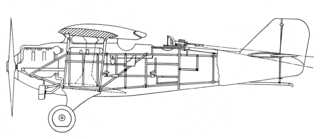Related Research Articles

The Gwinn Aircar was a single-engined biplane with a cabin for two, designed in the US as a safe and simple private aircraft. Lacking a rudder, it had several unusual control features as well as an early tricycle undercarriage. Development was abandoned after a crash in 1938.

The Skyeton K-10 Swift is a two-seat, single-engine light sports or ultralight aircraft designed in Ukraine.

The I.S.T. XL-14 Maya was a single-engine, light experimental aircraft designed and built in the Republic of the Philippines in the early 1950s to investigate the use of indigenous materials in aircraft construction. Its construction uses a type of woven bamboo.
The Eurofly FB5 Star Light is a single engine kit built Italian ultralight, seating two side by side. It first flew in the late 2000s.
The Kieger AK3 is conventionally laid out single engine, tractor configuration, low wing two seat light aircraft built in France from 2006. At least two have flown.

The Groppo XL and Groppo Trail are very similar single engine, tandem seat, high wing ultralight aircraft designed and built in Italy. Both can be supplied complete or in kit form. The two models differ chiefly in undercarriage type.
The Swift Aircraft Swift is a single engine, conventional light aircraft, seating two in side-by-side configuration. It is being developed in the UK but has yet to fly.

The Timm T-840 was a twin engine, high wing passenger aircraft designed and flown in the United States in 1938. Equipped with a tricycle undercarriage and low speed aerodynamic devices, it could be configured to carry between six and ten passengers. Only one was built.
The Escapade Kid is a single-engine, single-seat, high-wing monoplane, developed and built in the United Kingdom in the 2000s.
The Nicollier HN 500 Bengali is a single engine French light aircraft built in France in the 1980s. It seats two in side-by-side configuration. Only one was built, flying for the first time in 1988; it remains active with a French preservation group.
The ViS Sprint is a pusher configuration, pod-and-boom two-seat ultralight, designed and built in the Ukraine in the mid-2000s. It can serve as an agricultural spraying aircraft.
The IIL IS-8 was a two-seat sailplane designed by Iosif Șilimon and built in Romania in 1960. They served with Romanian gliding clubs.
The IIL IS-10 was a high-performance, single-seat glider, designed and built in Romania in the early 1960s. It was the first Romanian aircraft to use laminar flow airfoils.
The MMPL Kanpur was an Indian light four-seat aircraft, designed for service and agricultural work in the early 1960s. It is a rare example of an aircraft designed and built by a national air force for its own use.
The Chasle YC-10 Migrateur was a single seat sports aircraft built in France in the early 1980s. Only one was built and it flew for less than 30 hours.
The Marc Parrot, named after the Punta Parrot peak in the Monte Rosa Massif, was specifically designed to fly into unprepared fields and mountain landing strips. The prototype first flew in 2013 but no more had been completed by about 2015.
The Aviad Zigolo MG12 is an Italian kitbuilt introductory motor-glider first flown in 2012. It has a small engine and limited gliding performance but is inexpensive to buy and run and simple to build and fly. Kit production began in 2013 and by the following year twenty had been sold.

The Bréguet 25 or XXV was a French two seat fighter from 1925. It was heavily armed, carrying seven machine guns.
The Morane-Saulnier MS.152 was a French multi-purpose aircraft built in 1928. It did not go into production.
The Orliński RO-7 Orlik (Eaglet) was a prize-winning Polish home-built aircraft, first flown in 1987. It was restored to flight, with improvements, in 2003.